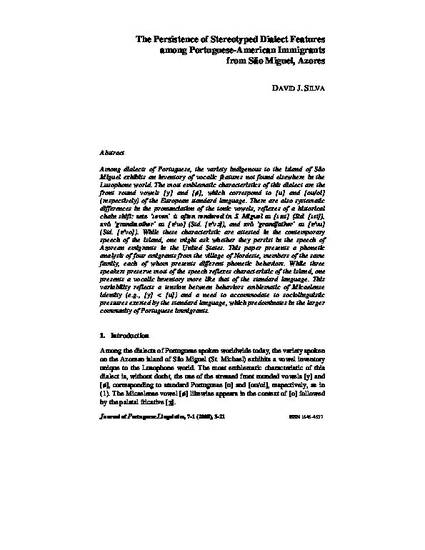
Article
The Persistence of Stereotyped Dialect Features among Portuguese-American Immigrants from São Miguel, Azores
Journal of Portuguese Linguistics
(2008)
Abstract
Among dialects of Portuguese, the variety indigenous to the island of São Miguel exhibits an inventory of vocalic features not found elsewhere in the Lusophone world. The most emblematic characteristics of this dialect are the front round vowels [y] and [ø], which correspond to [u] and [ou/oi] (respectively) of the European standard language. There are also systematic differences in the pronunciation of the tonic vowels, reflexes of a historical chain shift: sete ‘seven’ is often rendered in S. Miguel as [sæt] (Std. [sεt]), avó ‘grandmother’ as [ɐ'vo] (Std. [ɐ'vɔ]), and avô ‘grandfather’ as [ɐ'vu] (Std. [ɐ'vo]). While these characteristic are attested in the contemporary speech of the island, one might ask whether they persist in the speech of Azorean emigrants in the United States. This paper presents a phonetic analysis of four emigrants from the village of Nordeste, members of the same family, each of whom presents different phonetic behaviors. While three speakers preserve most of the speech reflexes characteristic of the island, one presents a vocalic inventory more like that of the standard language. This variability reflects a tension between behaviors emblematic of Micaelense identity (e.g., [y] < [u]) and a need to accommodate to sociolinguistic pressures exerted by the standard language, which predominates in the larger community of Portuguese immigrants.
Disciplines
- History and
- Linguistics
Publication Date
June 30, 2008
DOI
10.5334/jpl.133
Citation Information
David J. Silva. "The Persistence of Stereotyped Dialect Features among Portuguese-American Immigrants from São Miguel, Azores" Journal of Portuguese Linguistics Vol. 7 Iss. 1 (2008) p. 3 - 21 Available at: http://works.bepress.com/david-silva/10/
Creative Commons license

This work is licensed under a Creative Commons CC_BY International License.
